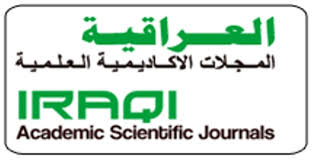Images of torment in Iraqi theater publications
the play “Martyrs Do Not Enter Paradise As model
DOI:
https://doi.org/10.59767/2023.11/27.11Keywords:
Iraqi Theatre, Abdul-Nabi Al-Zaidi, Pictures of Torment, The Play, AbsurdityAbstract
The theater is filled with images of torment, and the sentence of torment here is more general and comprehensive than any other expression such as pessimism, sadness and alarm, for example, the torment represents the biggest concern in the Zaidi theater in general, and in the play of martyrs first enter paradise in particular.
The idea of the torment inflicted by everyone, the martyr and his mother, without a clear explanation, leads to the idea of general punishment, which seems to some extent acceptable to the mind, especially the feeling of sin, which made both Shahid 1 and Shahid 2 admit that he does not deserve to be a martyr, especially after they were thrown into destructive wars that are useless except for masters with higher interests, Religion has nothing to do with it except an illusion used by politicians to incite war to reap their own fruits. Both martyrs appear to be in a state of permanent crucifixion, criticizing a vague hope to come. Here, Al-Zaidi gets very close to Beckett's theater in the game of thinking about the sin committed, which is the use of the war machine to kill without justification or real purpose.
To turn the play into the point of view of its author towards war and the destruction, devastation and illusions it produces, to turn the same point of view into one of the most important forms of torment in the theater of Ali Abdul Nabi Al-Zaidi.
References
Ibrahim Hamada. (1985). A dictionary of dramatic and theatrical terms. Cairo: Dar Al-Maaref.
Al-Araji Bashar. (No date). Intellectual and aesthetic discourse in the presentations of Ali Abd al-Nabi al-Zaidi’s theatrical texts. 46.
Bashar Al-Araji. (2017). Intellectual and aesthetic discourse in the presentations of Ali Abdulnabi Al-Zaidi’s theatrical texts. 41-42.
Jalal Al Ashry. (1989). The curtain did not close. Cairo: Egyptian General Book Authority.
Josine Jawdat. (1982). Theater of the Absurd in France. Fusoul Magazine (3), 109.
Sameh Mahran. (2021). Theater between creativity and reception. Cairo: General Book Authority.
Samia Asaad. (No date). Introduction to the play Misunderstanding, written by Alberkami. (Samia Asaad, The Translators) International Plays, 15.
core. (2016). The play, Lord: The sacred between the authorities of religion and reason. Al-Zaman newspaper (5444). Retrieved from www.azzaman.com
Amer Hadi. (2020). Secular thought in the texts of the Iraqi playwright Ali Abdulnabi Al-Zaidi. Alexandria: Alexandria University, Faculty of Arts.
Amer Hadi. (No date). Previous reference. 70.
Ghosun Al-Obaidi. (No date). Frustration among Ali Abdulnabi Al-Zaidi’s theatrical characters. 1153-1154.
Within Al-Obaidi. (2014). Frustration among Ali Abdulnabi Al-Zaidi’s theatrical characters. Babylon University Journal of Human Sciences, 22(5), 1152.
Group of authors. (2005). The third time, the theater and the millennium variables. Sharjah Publications.
Muhammad Al-Ashmawy. (1994). Studies in contemporary literary criticism. Cairo: Dar Al Shorouk.
Muhammad Anani. (1995). One of the modern bear issues. Cairo: Egyptian General Book Authority.
Al-Banhawi Club. (1998). The seeds of absurdity in Greek tragedy and their impact on contemporary absurdity theater in the West and Egypt. Cairo: Egyptian General Book Authority.
Nabil Ragheb. (1998). Encyclopedia of literary thought. Cairo: Egyptian General Book Authority.
Naeem Attia. (1992). Theater of the Absurd: (its concept, roots, and signs). Cairo: Egyptian General Book Authority.
Nawal Zein El Din. (1998). The absurd and absolute time. Cairo: Egyptian General Book Authority.
Abdulaaly, S. N. (2023). Breaking the taboo in the divinities of Ali Abd al-Nabi al-Zaidi. Basrah Arts Journal(24), pp. 117-133.
Aldaghlawy, H. J. (2013). human rights & directing treatments in the Iraqi theatrical performance. University of Basrah. doi:https://doi.org/10.5281/zenodo.7779863
Kareem, N. S., & Aldaghlawy, H. J. (2022). Pictures of death in the Iraqi theatrical performance. Basrah Arts Journal(22), pp. 187-206. doi:https://doi.org/10.59767/bfj.5300.1976
Downloads
Published
How to Cite
License
Copyright (c) 2023 Adnan Hussain Ali

This work is licensed under a Creative Commons Attribution 4.0 International License.







